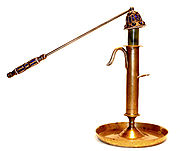
Candle snuffer
Encyclopedia

Candle
A candle is a solid block or cylinder of wax with an embedded wick, which is lit to provide light, and sometimes heat.Today, most candles are made from paraffin. Candles can also be made from beeswax, soy, other plant waxes, and tallow...
s. This is accomplished by smothering the flame with a small metal cup that is suspended from a long handle, and thus depriving it of oxygen. The use of a candle snuffer helps to avoid problems associated with blowing hot wax
Paraffin
In chemistry, paraffin is a term that can be used synonymously with "alkane", indicating hydrocarbons with the general formula CnH2n+2. Paraffin wax refers to a mixture of alkanes that falls within the 20 ≤ n ≤ 40 range; they are found in the solid state at room temperature and begin to enter the...
. Candle snuffers are commonly used in homes and churches.
Older type

An older meaning refers to a scissor-like tool used to trim the wick
Candle wick
A candle wick is a string, cord, or wooden object that holds the flame of a candle. A candle wick works by capillary action, drawing the fuel to the flame. When the liquid fuel, typically melted candle wax, reaches the flame it then vaporizes and combusts. The candle wick influences how the...
of a candle. With skill, this could be done without extinguishing the flame. A small receptacle catches the trimmed bit of wick. This tool was rendered obsolete by the invention of self-snuffing wicks, which curl out of the flame when charred. This allows excess wick to burn away, preventing the wick from becoming too long. The instrument now known as a candle snuffer was formerly called an "extinguisher" or "doubter".
Many antique dealers use either term at random. The correct term might be more properly applied according to the age of the implement. While the invention of the self consuming wick discontinued their need a "snuffer" remains a snuffer and does not change into an extinguisher.

